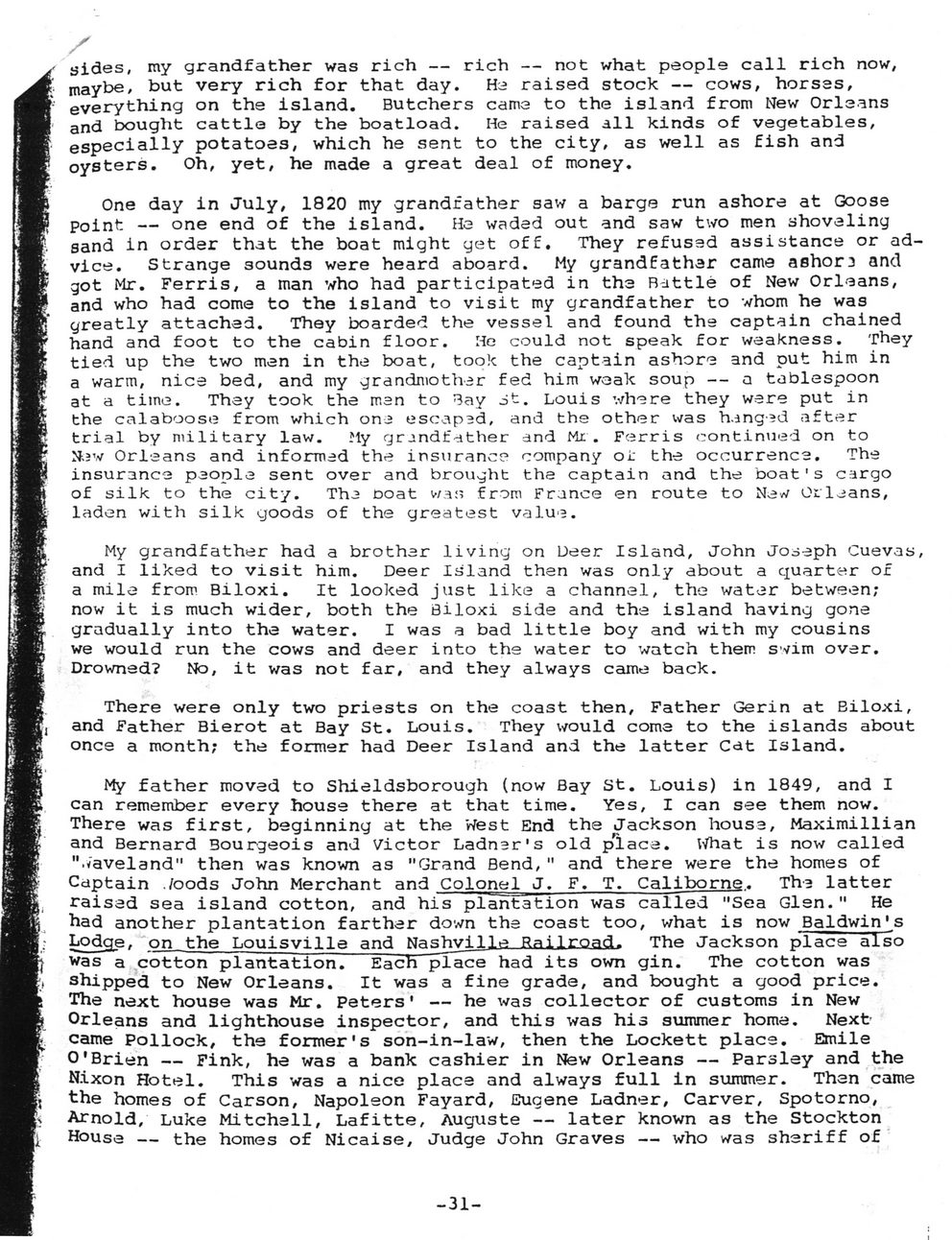This text was obtained via automated optical character recognition.
It has not been edited and may therefore contain several errors.
/ sides, my grandfather was rich ? rich -- not what people call rich now, maybe, but very rich for that day. He raised stock ? cows, horses, everything on the island. Butchers cama to the island from New Orleans and bought cattle by the boatload. He raised all kinds of vegetables, especially potatoes, which he sent to the city, as well as fish and oysters. Oh, yet, he made a great deal of money. One day in July, 1820 my grandfather saw a barge run ashore at Goose point ? one end of the island. He waded out and saw two men shoveling sand in order that the boat might yet off. They refused assistance or advice. Strange sounds were heard aboard. My grandfathar came ashore and got Mr. Ferris, a man who had participated in the Rattle of New Orleans, and who had come to the island to visit my grandfather to whom he was greatly attached. They boarded the vessel and found the captain chained hand and foot to the cabin floor. He could not speak for weakness. They tied up the two men in the boat, took the captain ashore and put him in a warm, nice bed, and my grandmother fed him weak soup ? a tablespoon at a time. They took the men to 3ay it. Louis where they were put in the calaboose from which one escapad, and the other was Hanged after trial by military law. ?ly grandfather and Mr. Ferris continued on to New Orleans and informed the insurance company oi' the occurrence. The insurance people sent over and brought the captain and the boat's cargo of silk to the city. The ooat was from France en route to Ne*/ Orleans, laden with silk goods of the greatest value. My grandfather had a brother living on Deer Island, John Joseph Cuevas, and I liked to visit him. Deer Island then was only about a quarter of a mile from Biloxi. It looked just like a channel, the water between; now it is much wider, both the Biloxi side and the island having gone gradually into the water. I was a bad little boy and with my cousins we would run the cows and deer into the water to watch them swim over. Drowned? No, it was not far, and they always came back. There were only two priests on the coast then, Father Gerin at Biloxi, and Father Bierot at Bay St. Louis. They would come to the islands about once a month; the former had Deer Island and the latter Cat Island. My father moved to Shieldsborough (now Bay St. Louis) in 1849, and I can remember every house there at that time. Yes, I can see them now. There was first, beginning at the West End the Jackson house, Maximillian and Bernard Bourgeois and Victor Ladner's old place. What is now called "waveland" then was known as "Grand Bend, " and there were the homes of Captain .foods John Merchant and Colonel J. F. T. Caliborne. The latter raised sea island cotton, and his plantation was called "Sea Glen." He had another plantation farther down the coast too, what is now Baldwin1s Lodge, on the Louisville and Nashville Railroad. The Jackson place also was a cotton plantation. Each pTace had its own gin. The cotton was shipped to New Orleans. It was a fine grade, and bought a good price. The next house was Mr. Peters' ? he was collector of customs in New Orleans and lighthouse inspector, and this was his summer home. Next-came Pollock, the former's son-in-law, then the Lockett place. Emile O'Brien ? Fink, he was a bank cashier in New Orleans ? Parsley and the Nixon Hotel. This was a nice place and always full in summer. Then came the homes of Carson, Napoleon Fayard, Eugene Ladner, Carver, Spotorno, Arnold, Luke Mitchell, Lafitte, Auguste ? later known as the Stockton House ? the homes of Nicaise, Judge John Graves ? who was sheriff of -31-

Cuevas 089